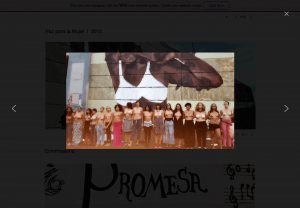In the beginning, I was wary of choosing quotes for this project. The process was slow, and it felt as if I was getting nowhere. I was stuck in my own positionality as a white women, and how I should go about presenting the information I have learned in this course, from predominantly women of color, and Black women. However, this class has furthered the realization that I may garner the lived knowledges of Black and Brown women and implement those knowledges in productive ways; and that even if I am not always correct, there is always room for growth and learning. I wanted to begin my piece with an introduction to one of the focal points of this class which was the effects of colonization, from which I moved on to more nuanced statements and quotes about how colonized women have learned to decolonize their lives and spaces.
My choices in using Lugones and Anzaldúa were in part because of my perceived connection to the sentiments of them, while also keeping in mind that I may activate them in slightly different ways that the author. I would like to flesh out a little more about my choice from María Lugones’, “The Coloniality of Gender”; I chose this quote not to bring attention to the horrendous ways that colonized women, including enslaved women, were treated, but rather something more relevant to myself. I wanted to bring attention to the way white womanhood is characterized, and how it is the job of white women to recharacterize themselves, how it is their (and my own) job to counter the notion that we are not, “fragile and sexually passive,” with the notion that we are no better than our Black Brown counterparts. (Lugones) I went on to bring attention to the interconnectedness of the colonization of Black bodies and Native/Indigenous bodies, as neither may be decolonized without the other, and this means reparations and sovereignty for all groups. This sentiment is not one I have heard many times before, but one that I would like to uplift because of its relevance to the colonized Black and Brown women of Puerto Rico.
Perhaps one of my favorite quotes from the collection was that of Paula Gunn Allen’s, “Some Like Indians Endure,” because of the sheer bluntness of it; ‘because whiteman took//all the rest.’ (Gunn Allen) Gunn Allen’s words spoke to the words of many other authors from this semester, in two simple lines. Following Gunn Allen, I chose another work of Lugones, from “Toward a Decolonial Feminism,” and Emma Peréz’s “Queer Subaltern Citizens: Agency through Decolonial Queer Theory,” to discuss that the work of decolonial studies falls on no one identity, or community, but rather on all identities and communities. I also wanted to touch on the importance of finding decolonial/postcolonial/anticolonial knowledges within survival, resistance, opposition and reconstruction movements/happenings.
The final quote that I chose for this collection may not resonate with me in the manner which the author resonated with it, such is most literature. This quote for me meant that listening to and learning about the stories of other colonized peoples and bodies will help connect each of us to one another; it will help bring together those affected by colonization, which is inevitably everyone on this Earth. This quote meant that through learning and understanding all of the ways the people of the world, and the world itself has been harmed, we will come into our own ways of healing our suffering and decolonizing our minds.
INSTAGRAM POST QUOTE COLLECTION (in order):
“Western Civilization is eating up the world, tearing great hunks of it from the bone.” Aurora Levins Morales, “1900: Civilization─Europe,” Remedios, p. 165
“We are not self-important, we are not fixed in particular constructions of ourselves, which is part of saying that we are open to self-construction.” María Lugones, Playfulness, “World”-Travelling, and Loving Perception, p. 16
“The struggle is inner: Chicano, indio, American Indian, mojado, ;nexicano, immigrant Latino, Anglo in power, working class Anglo, Black, Asian—our psyches resemble the bordertowns and are populated by the same people. The struggle has always been inner, and is played out in the outer terrains. Awareness of our situation must come before inner changes, which in turn come before changes in society. Nothing happens in the “real” world unless it first happens in the images in our heads.” Gloria Anzaldúa, Towards a New Consciousness, p. 109
“Historically, the characterization of white European women as fragile and sexually passive opposed them to non-white, colonized women, including women slaves, who were characterized along a gamut of sexual aggression and perversion, and as strong enough to do any sort of labor.” María Lugones, The Coloniality of Gender, p.13
“Current structures of oppression are situated historically and relationally: to undo slavery’s legacies for Black communities, the territorial dispossessions of Indigenous peoples must be undone as well. And vice versa.” Joanne Barker, Indigenous Feminisms, p. 12
“If we acknowledge that the sovereignty of the land continues to persist and is Indigenous, then we have to challenge the legitimacy of the United States. This kind of approach asks us to pay attention to, work with, and be accountable to the ways in which global processes play out on Indigenous bodies in the places where we live rather than just in those places where we work.” Hokulani K. Aikau, Maile Arvin, Mishuana Goeman, Scott Morgensen, Indigenous Feminisms Roundtable, p. 86
the place where we live now
is idea
because whiteman took
all the rest
Paula Gunn Allen, “Some Like Indians Endure,” Haciendo Caras, p. 299
“One does not resist the coloniality of gender alone. One resists it from within a way of understanding the world and living in it that is shared and that can understand one’s actions, thus providing recognition.” María Lugones, Toward a Decolonial Feminism, p. 754
“And if I am persistent, I’ll find within those colonial ideologies the subjugated knowledges of people who created ways to survive, resist, oppose and reconstruct those ideologies.” Emma Peréz, Queer Subaltern Citizens: Agency through Decolonial Queer Theory, p. 24-25
“But if you take these stories as bitters, your own pain will dissolve into the larger stream of pain and you will find comfort with these women, for the poison they suffered and died from is the same poison, and if you eat bitters, drink bitters, speak bitterness with them, you will be cleansed. You will be healed.” Aurora Levins Morales, “Bitters,” Remedios, p. 64
https://www.instagram.com/p/BxBqoZhHOQi/?igshid=mp5nv98940nc



